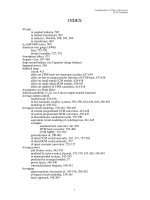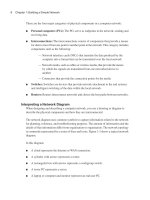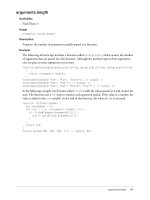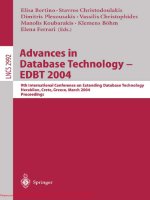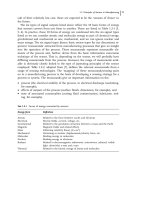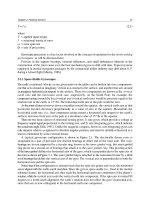Tài liệu Sensors in Intelligent Buildings P2 pptx
Bạn đang xem bản rút gọn của tài liệu. Xem và tải ngay bản đầy đủ của tài liệu tại đây (194.16 KB, 10 trang )
view). Nevertheless, in terms of industrial applications, other characteristics be-
sides the transduction principle become more important, namely technology, ma-
terials, accuracy, and costs. The insides of sensor systems become less important
from an application perspective.
All sensor systems are facing a noticeable upward trend in performance require-
ments for maintenance, down-time, reliability, fault tolerance, fault recovery, and
adaptability. Industrial applications in the area of consumer goods are also subject
to cost pressure, where the value of electronic products has risen while costs have
continuously fallen in past decades.
Current trends in sensor systems can be summarized as follows (see Figure
1.1-10):
1. Higher performance of sensors. Sensor accuracy and linearity, both classical prob-
lems of sensor systems, have been improved in all areas. Today’s sensor systems
also work under better conditions and with higher reliability. Greater demands for
environmental protection have led to the development of highly reliable sensors.
Development efforts are still focused on maintenance-free sensors with long life
expectancy and low electric power dissipation.
New sensors have been developed, such as torque sensors, accelerometers,
acoustic sensors, pattern information-sensing devices, and smell sensors. Olfac-
tory sensors and voice recognition combined with synthetic speech generation
technology will make remote-controlled home appliances a reality.
1.1 Sensors in Intelligent Buildings: Overview and Trends 19
Fig. 1.1-10 Trends in sensor systems
2. Smart sensor systems. Smart sensor systems are usually complex systems with in-
tegrated intelligence. Sensor technology has developed towards a stronger integra-
tion of signal transformation and signal processing. Microprocessors and sensors
build an integrated unit for measuring and controlling technology. Sensors and
signal processing have to be brought together at the place of measurement. These
‘smart sensors’ are characterized by an integral electronic design, optimized for
defined applications. As a result, higher speeds will permit sensor signal proces-
sing. In addition, the integration of sensors and related electronic circuits will
lead to lower costs.
Intelligent sensor systems rely on a set of algorithms and rules (knowledge
base) which connect the signal enhancement from the sensors to the sensor out-
put. Two kinds of knowledge are important:
· empirical knowledge, which includes model-based calculations, hard rules
about the process, and soft (fuzzy) rules based on experience;
· analytical knowledge, which includes extrapolation from the past, involvement
of the neighborhood, and learning from success (analytical of neuronal).
3. Multi-sensor systems. R&D in sensor technology is tending towards self-identify-
ing, self-diagnosing, and self-calibrating sensors. Today there are already several
sensor systems which integrate different transduction principles in a single sen-
sor system, ie, mechanical, thermal, and optical. The output signals of several
simple sensors are computed in parallel by a secondary processing unit. These
multi-sensor systems create powerful and precise systems with high selectivity.
New algorithms for pattern recognition support built-in self-supervision and in-
crease the reliability of the sensor system.
4. Miniaturization of sensor systems. Driven by high-tech sectors, such as the aero-
space, medical, and entertainment industries, sensor systems have been pushed
towards smaller scale devices. Examples are the integration of optical sensors in fi-
ber technology and intelligent noses with biochemical sensors. In the future the
importance of nanotechnology for sensor systems will increase further and open
up access to new and smaller dimensions.
5. Integration of sensor-actor systems. Sensor systems are becoming smaller in size
and lighter in weight, which allows further integration of sensor and actor sys-
tems. This trend became especially important in the area of mechatronics, a fu-
sion of mechanical and electronic areas at a miniaturized level.
6. Standardization of sensor interfaces. Across industries and applications, the impor-
tance of standardized interfaces has been on the increase. Economies of scale due
to mass production of sensors have led to lower costs. Even complex sensor sys-
tems have become commodity items because of standardized interfaces and inte-
grated designs for sensor systems and control systems. Standardization allows eas-
ier handling of sensor systems. Some industries support elaborate and advanced
standards, such as the CAMAC system in the nuclear industry. The standardiza-
1 Introduction20
tion constraints, however, mainly apply to the communication aspects of sensor
systems (external interfaces); the internal operation of industrial sensor systems
remains open to free development [12].
7. Cost reduction in sensor systems. A direct impact of standardization is high-volume
production and thus cost reduction. In general, sensor technology has become
more smart, integrated, and standardized. Industrialization and the trend towards
more functionality at lower cost are the main drivers. The automotive industry
has already demonstrated these trends. When the topic of intelligent sensors
came up in the field of instrumentation in the late 1970s, it was greeted with
some skepticism in industrial communities because of the cost and the current
stage of development of computer technology [12]. Today, low-cost systems pro-
duced in high volumes provide both intelligence and reliability.
The enablers of these trends are new developments such as material technol-
ogy, sensor and actuator technology, microelectronics/optoelectronics/information
storage, electro-optical and electromechanical transducers, generation/distribu-
tion/storage of electrical energy, information engineering, intelligence functions,
and software. Major drivers include large efforts in research and development of
high-tech industries in the area of microelectronics in the 1970s, in new materials
and information technology in the 1980s, and in miniaturization and integration
in the 1990s [13]. Huge improvements have been made in the manufacturability
of sensor systems. This includes the integration of sensorics, actuators, ASICs,
and mechatronics as well as communication elements into one system.
At the same time, the complexity of the sensor-actor systems has increased drama-
tically. The management of the increased complexity in R&D laboratories will be a
critical success factor in the future, according to Bill Raduchel, Chief Strategy Offi-
cer of Sun Microsystems: ‘The challenge over the next 20 years will not be speed or
cost or performance; it will be a question of complexity.’ Future sensor systems will
be independent, teachable, or adaptable systems, which will extend their geometries
into the nano range, include non-electrical signal processing components, and will
be based partly on materials from high-temperature electronics [13].
1.1.4
Sensor Systems in Intelligent Buildings
In the following sections of this book we focus on those areas of an intelligent
building where we expect the biggest impact of sensor and control technologies.
These are
· energy and HVAC;
· information and transportation;
· safety and security;
· maintenance and facility management;
· system technologies.
1.1 Sensors in Intelligent Buildings: Overview and Trends 21
1.1.4.1
Energy and HVAC
Albert So and Brian Tse describe intelligent air-conditioning control systems. After a
review of conventional physical sensors, three new concepts and their associated de-
velopments in sensing technology are discussed. Computer vision traces people
movement and people flow in order to make the most intelligent decision for opti-
mal HVAC control. Internet-based control permits fully remote monitoring and op-
eration of building systems. Comfort-based control is highlighted as the future stan-
dard; the authors suggest the use of the predicted mean vote (PMV) as comfort index.
A self-commissioned heating control system, called NEUROBAT, is introduced
by Jens Krauss, Manuel Bauer, Jürg Bichsel, and Nicolas Morel. The heating control-
ler is predictive and adaptive and thus able to achieve energy savings and ensure
optimal thermal comfort. Artificial neural networks permit the adaptation of the
control model to real conditions, such as climate, building characteristics and user
behavior. First empirical results at a real site have shown huge energy savings.
Hanns-Erik Endres focuses on the measurement and management of air quality.
Gas sensors play an important role in this.
An optimal sensor-based management of energy and thermal comfort in build-
ings is discussed by Thomas Bernard and Helge-Björn Kuntze.
The automatic and remote reading of consumption data recorded by meters in-
stalled in residential buildings is an important element of energy management.
Dieter Mrozinski gives an overview of the opportunities of wireless and M-bus-en-
abled metering devices.
Since user behavior regarding energy consumption can be positively influenced
by metering individual energy consumption, sensors for metering are recom-
mended by the European Union. Günter Mügge describes such sensors and the
means of energy cost allocation.
Pressure sensors for the HVAC industry are described by Yves Lüthi, Rolf Meisin-
ger, Marc Wenzler, and Kais Mnif. Special requirements from the HVAC industry
are low pressure ranges, simple installation, independence of mounting orienta-
tion, low sensitivity to dirt, robustness, a long lifetime, and low costs. Several solu-
tions of pressure sensors which meet these requirements are discussed.
1.1.4.2
Information and Transportation
Fieldbus systems enable decentralized control structures and therefore often lead
to lower system costs and higher system reliability. Dietmar Dietrich, Peter Fischer,
Dietmar Loy, and Thilo Sauter give an overview of fieldbusses. This includes the
basics of the communication techniques, used in fieldbus systems, as well as a
short history and an overview of EIB and LonWorks. Challenges which still re-
main include interoperability and demands for agent-based systems.
Wireless in-building networks are discussed by Mike Barnard, who focuses on
low-power/low-bandwidth networks suitable for sensors, telemetry, etc. He also
1 Introduction22
gives an overview of existing and emerging standards and products, related to
wired and wireless links from and to sensors.
Sensor systems in modern high-rise elevators are discussed by Enrico Marchesi,
Ayman Hamdy, and René Kunz. In order to travel higher and faster than ever be-
fore, elevators need excellent shaft information systems. Modern elevators travel
at 10 m/s up to 500 m in height with horizontal vibrations of less than 10 mg.
The authors explain an active ride control system, which relies heavily on fast and
accurate sensors.
The perceptual user interface of a future intelligent office building includes in-
formation on all elements in a room. Opportunities and first empirical results of
sensing chair and floor interaction by using distributed sensors are presented by
Hong Z. Tan, Alex Pentland, and Lynne A. Slivovsky. The key problem is the auto-
matic processing and interpretation of touch sensor information and the model-
ing of user behavior leading to such sensory data.
1.1.4.3
Safety and Security
Marc Thuillard, Peter Ryser, and Gustav Pfister give an overview of life safety and
security systems in intelligent buildings. These systems provide early warning of
dangerous situations in buildings, eg, fire incidents, toxic or explosive gas concen-
trations, and unwanted intrusion into premises. They discuss technologies and
physical principles of those sensors, including the complete alarm systems and
emergency systems involved.
Biometric sensing systems represent innovative technologies for access control.
Christoph Busch describes opportunities of biometric authentication for access
control. Pattern recognition is one of the key areas.
Smart cameras and their applications in intelligent buildings are outlined by
Bedrich J. Hosticka. Smart cameras possess built-in intelligence and allow en-
hanced imaging under critical light conditions, as well as low-cost image process-
ing. New camera technology, called CMOS-based imaging, is introduced by the
author.
Peter L. Fuhr and Dryver R. Huston outline new sensing systems and techniques
for improved construction site safety. Sensor systems are designed for monitoring
construction site shoring and scaffolding. Such a sensor network can provide in-
formation about the load distribution on shoring systems and thus increase per-
sonal safety. The solutions presented have already been tested on field sites.
1.1.4.4
Maintenance and Facility Management
New forms of maintenance management in industrial installations are described
by Jerry Kahn. Predictive maintenance and periodical condition monitoring are the
key elements. Sensor systems are required to measure and analyze equipment
conditions and predict future equipment performance.
1.1 Sensors in Intelligent Buildings: Overview and Trends 23
Rolf Reinema from the GMD Institute for Secure Telecooperation discusses the
opportunities presented by world-wide facility management. Office environments
and their interiors are monitored, controlled, and managed from a globally stan-
dardized platform, abstracted from particular local technology. A smart, embedded
system, called roomServer, bridges the gap between physical and virtual work en-
vironments.
1.1.4.5
System Technologies
General trends in sensor systems in intelligent buildings are summarized by
Hans-Rolf Tränkler and Olfa Kanoun . Friedrich Schneider et al. outline system tech-
nologies for private homes.
Future buildings will become more intelligent. The main trends will be reduced
resource consumption, optimized convenience, and more comfort as well as better
safety and security. Following other industries such as the automotive industry, the
building industry will experience an increased impact of microsystems technologies
and new communication systems. Within these trends, new sensor systems with
higher performance characteristics will be key technologies and enablers. The per-
formance of these sensor systems will increase regarding accuracy and linearity,
maintenance, down-time, reliability, fault tolerance, fault recovery, and adaptabil-
ity. Sensor systems themselves will become smarter and more integrated. Multi-sen-
sor systems will be increasingly widespread, used with self-identifying, self-diagnos-
ing, and self-calibrating sensors. Within the next 10 years megatrends will be min-
iaturization, standardization of interfaces, and the close integration of smart sensors
with actuators. Higher volumes will lead via economies of scale to low-cost sensor
systems. Therefore, most visionary sensor system applications which are described
in this book will become tomorrow’s commodity products.
1 Introduction24
1.1.5
References
1 Kaye, J., Working paper; Boston: MIT
Media Laboratories, 1998.
2 Streitz, N. A., Geissler, J., Holmer, T.,
Konomi, Sh., Müller-Tomfelde, Ch.,
Reischl, W., Rexroth, P., Seitz, P.,
Steinmetz, R., in: Proceedings of the
ACM Conference on Human Factors in
Computing Systems; Pittsburgh, PA: May
15–20, 1999.
3 OECD, 21st Century Technologies: Promises
and Perils of a Dynamic Future; Paris:
OECD, 1998.
4 Festo, presented at IASS International
Association for Shell and Spatial Struc-
tures Symposium, University of Stutt-
gart, 7–11 October 1996.
5 Festo, Portable Architecture; London: Roy-
al Institute of British Architects, 1997.
6 Festo, in: Metropolis; New York, Decem-
ber 1998, pp. 45–49.
7 Festo, Archit. Rec. (1999) 218.
8 Festo, Design Net 30 (2000) 145.
9 Kobayashi, T., in: Sensors. A Comprehen-
sive Survey, Göpel, W., Hesse, J., Zemel,
J. N. (eds.); Weinheim: Wiley VCH, 1989,
Vol. 1, pp. 425–443.
1.1 Sensors in Intelligent Buildings: Overview and Trends 25
10 Lion, K. S., IEEE Trans. IECI-16 (1969)
2–5.
11 Grandke, T., Hesse, J., in: Sensors. A
Comprehensive Survey, Göpel, W., Hesse,
J., Zemel, J. N. (eds.); Weinheim: Wiley-
VCH, 1989, Vol. 1, pp. 1–16.
12 Brignell, J.E., Smart Sensors, in: Sen-
sors. A Comprehensive Survey, Göpel, W.,
Hesse, J., Zemel, J. N. (eds.); Weinheim:
Wiley-VCH, 1989, Vol. 1, pp. 331–353.
13 Meixner, H., in: Sensors. A Comprehen-
sive Survey, Göpel, W., Hesse, J., Zemel,
J. N. (eds.); Weinheim: Wiley-VCH, 1995,
Vol. 8, pp. 2–22.
2 Energy and HVAC
Sensors in Intelligent Buildings. Edited by O. Gassmann, H. Meixner
Copyright © 2001 Wiley-VCH Verlag GmbH
ISBNs: 3-527-29557-7 (Hardcover); 3-527-60030-2 (Electronic)
2.1.1
Introduction
A precise definition of a sensor (often called a detector in heating, ventilating, and
air-conditioning (HVAC) control) has always been elusive. For practical purposes,
a sensor in an HVAC system can be thought of as a device which converts a phys-
ical property (eg, temperature or humidity) or quantity (eg, flow rate) into a conve-
niently measurable effect or signal (eg, current, voltage, or number). For HVAC,
sensors can be grouped into the following types:
· temperature and humidity (enthalpy);
· pressure;
· flow rate;
· comfort;
· indoor air quality.
Most sensors consist of two ‘components’, ie, a transducer which converts the
raw, measured signal into a ‘convenient’ signal (usually electrical), and an asso-
ciated signal conditioner which ensures that the raw signal is converted to a scal-
able electrical signal which can be calibrated with the raw measured signal. Typi-
cally, a linear relationship between the convenient signal and the quantity of the
raw, measured signal is preferred. Recent and future generations of sensors have
an additional feature, ‘intelligence’, where a built-in microprocessor enables data
to be reported and analyzed besides pure measurement. Comfort and enthalpy
‘sensors’ are examples of this category.
2.1.2
General Specifications of a Sensor [1]
A sensor can be fully specified with reference to at least 12 performance, practi-
cal, and economic factors which can be divided into two classes.
29
2.1
Intelligent Air-conditioning Control
Albert T. P. So and Brian W.L. Tse , City University of Hong Kong, Hong Kong
Sensors in Intelligent Buildings. Edited by O. Gassmann, H. Meixner
Copyright © 2001 Wiley-VCH Verlag GmbH
ISBNs: 3-527-29557-7 (Hardcover); 3-527-60030-2 (Electronic)
Performance-based Factors
1. Range. The range of the measured variable for which the characteristics are
maintained at stated values.
2. Accuracy. The degree of equivalence to which the measured output matches
with some known benchmark.
3. Repeatability. The ability of the sensor to reproduce consistently the same out-
put from the same measured value.
4. Sensitivity. The smallest detectable change in measured value that results in
outputs change by the sensor.
5. Drift. The degree to which the sensor fails to give a consistent performance
throughout its stated life.
6. Linearity. The closeness to linear proportionality between the output and the
measured value across the range.
7. Response time. The rate of response with respect to time of the output follow-
ing an input change (often expressed as a time constant).
Practical and Economic Factors
8. Cost. The cost should include power supply, transducer, the signal condi-
tioner, and the connecting cables. Very often, the cost of installing the sensor
consumes a very significant portion within the overall cost.
9. Maintenance. Any special maintenance and re-calibration requirements in-
volving additional labor and expenses.
10. Compatibility. Interoperability and interchangeability with other components
and standards.
11. Environment. The ability to withstand harsh or hazardous environments.
12. Interference. Susceptibility to ambient ‘noise’ such as electromagnetic waves
or quasi-stationary electric or magnetic fields.
2.1.3
A Quick Review on HVAC Sensors
A brief description of various sensors installed in HVAC systems is as follows [1–
12].
2.1.3.1
Temperature Sensors
Temperature is an important controlled parameter inside an air-conditioned envi-
ronment because it is closely related to human comfort level as suggested by Fan-
ger [3]. Obviously, temperature sensors are the most common sensors in an air-
conditioning system. Usually, three types of temperature sensors are popular,
namely thermocouples, resistance temperature detectors (RTDs), and thermistors.
2 Energy and HVAC30

